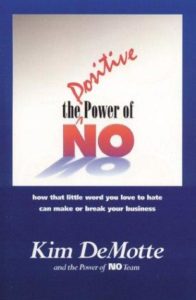 It’s been almost 20 years since I assembled the team that wrote the book, The Positive Power of NO. At the time there were dozens of books on the subject of YES: Getting to YES, Yes is the Answer, etc. I had gathered a half dozen of my fellow business consultants and asked if they found themselves counseling their clients to reign in the “you can do it” mantra and start to set limits. In other words, figuring out what to say no to.
It’s been almost 20 years since I assembled the team that wrote the book, The Positive Power of NO. At the time there were dozens of books on the subject of YES: Getting to YES, Yes is the Answer, etc. I had gathered a half dozen of my fellow business consultants and asked if they found themselves counseling their clients to reign in the “you can do it” mantra and start to set limits. In other words, figuring out what to say no to.
In retrospect, this was my introduction to the concept of clarity. I finally decided that if we’re always in yes mode, then we’re really not very clear about anything. At the time, I was coaching sales organizations with managers who wanted their teams to sell anything to anybody, at any price. Several of these teams appeared to have come right out of the movie Glengarry Glen Ross. In these cultures, no was simply half of a four-letter word.
The idea of introducing no as an acceptable word in a sales culture was a little revolutionary. I discovered that when teams learned that some sales weren’t as beneficial as others (too small, overly demanding, large but unprofitable), and allowed themselves to either accept no from the customer or prospect, or even say no themselves, good things happened. They saw improvement in the quality of contracts, longevity of customer relationships, and even the bottom line.
I spent several years perfecting a business prospecting system called catch and release. It helps highly paid sales people use their time wisely on prospects that don’t waste resources, lower profits, or in some way hinder the bottom line.
Making it Personal
While the catch and release model is quite pragmatic and valuable in sales processes, I began to see how it might help in my personal life. What would happen if I set limits as to what I would and would not invest my time and energy in, based on the outcomes I wanted?
There were two levels of this exercise I borrowed from the catch and release model. First, I had to get real clear about what I wanted…and how the limits formed between want and don’t want. Were they crisp and clear or were they fuzzy and ill defined? If I wanted a client who would pay me $25,000 in fees, would I accept $24,000? If the limits were fuzzy (i.e., I could move my no line easily) it produced stress. Should I flex? How much should I flex?
And second, did I have the guts to follow through on my no and turn down the latter? Could I, in fact, accept that this particular agreement does not produce what I want and pass on it in anticipation of a forthcoming agreement (because I am clear about what I want)?
I began to apply this idea of limits to more and more parts of my life. What did I want? What were my resource limitations? What did I need to say no to in order to get what I want with what I have?
How Clarity Has Helped Me
Those who know me understand my passion for the motorsport of rally. I have been involved in it for over 50 years. In the early years, I left or got fired from multiple positions in order to pursue rally.
Maybe my first real moment of clarity was when I figured out that rally and full-time employment weren’t going to be compatible. Based on my clarity—rally is what I wanted and full-time employment was going to stand in the way of that—I started working as a commission-only sales person. This gave me control over my time (and hence my rally schedule) and I found out I was good at it!
That led to launching several of my own ventures—aluminum, early PC computers, and software—to name a few. Eventually I became my own product; for the last 15 years or so I have made a wonderful living coaching individuals and small- to medium-sized companies in the search for and execution of clarity.
Approaching the end of yet another trip around the sun, I’d like you to ask yourself what you want. You may want to think about changing your New Year’s resolution from “I will” to “I will not” in defense of that aspiration. What do you need to give up in order to have what you want? What are you doing now as a habit or a ‘should’ that is actually impeding your true self?
‘Tis the season for introspection.
Merry Christmas and Happy New Year


Hey Kim, coming to Sno Drift? Hopefully not a “no” 🙂